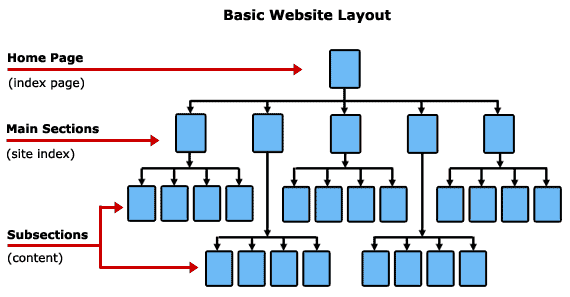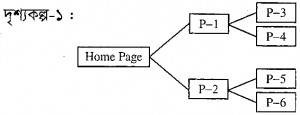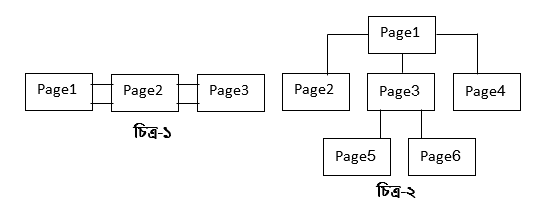At the end of this lesson-
- 1. You will be able to explain different types of pages of a website.
- 2. You will be able to explain structure of websites.
- 3. You will be able to explain different types of website structures.
- 4. You will be able to analyze different types of website structures.
Go for Bangla Version
Website’s structure:
A website’s structure refers to how the website is set up, i.e. how the individual sub-pages are linked to one another. It is particularly important that crawlers can find all sub-pages quickly and easily when websites have a large number of sub-pages.
For this reason, a website’s homepage needs to have links to the most important sub-pages. Based on the link of web pages, they are in different name. Normally there are three types of web pages in a website. For example- Home page, main pages and sub pages.

Home Page: A home page is a default or front page of a site that serves as the starting point of website. It is the first page that visitors see when they load a URL. It contains information about mission, vision, etc. and there is a menu bar where main pages are linked. This menu bar of the home page is called main section or “site index”.
Main pages: Main pages contain information about a particular division or section and the main pages are connected in a menu bar. For example- Web pages of different departments of a University are linked in the menu bar of the home page. This pages of different departments are called main pages.
Sub pages: Sub pages contain details information about a particular topic or subject and they are linked with main pages. For example- Web pages of different departments of a University are linked in the menu bar of the home page. This pages of different departments are called main pages. Again there are some pages that contain detail information about admission, syllabus, notice etc. of a particular department and they are linked with main page. Then these web pages are called sub pages.
There are four types of website’s structures according to the characteristics of websites. They are –
1. Linear/Sequential structure
2. Tree/Hierarchical structure
3. Network/Web linked structure
4. Hybrid/Combinational structure
Linear/Sequential structure:
The simplest and most familiar way to organize information is to place it in a sequence. This is the structure of books, magazines, and all other print matter. Sequential ordering may be chronological, a logical series of topics progressing from the general to the specific, or alphabetical, as in indexes, encyclopedias, and glossaries.
Straight sequences are the most appropriate organization for training or education sites, for example, in which the user is expected to progress through a fixed set of material and the only links are those that support the linear navigation path.

Tree/Hierarchical structure:
These are possibly the most common types of website structures. Because web sites are usually organized around a single home page, which then links to subtopic menu pages, hierarchical architectures are particularly suited to web site organization. Sometimes this structure is called tree structure, and it is very familiar in corporate and institutional life, so most users find this structure easy to understand.
Most web sites adopt some form of multi tiered hierarchical or tree architecture. This arrangement of major categories and subcategories has a powerful advantage for complex site organization in that most people are familiar with hierarchical organizations, and can readily form mental models of the site structure.

Network/Web linked structure:
In this structure, all the web pages of a website are linked with each other directly. The frame is used to present the links in a list. This frame remains fixed and if a link is clicked, the web page is displayed in the large frame.
It is the most impractical structure for web sites because they are so hard for the user to understand and predict. This structure works best for small sites dominated by lists of links and for sites aimed at highly educated or experienced users looking for further education or enrichment and not for a basic understanding of a topic.

Hybrid/Combinational structure:
In this structure, web pages of a website are linked using different multiple structures. Today most of the websites follow this structure. For example- some pages are linked in sequentially and some are linked in hierarchically.

Lesson Evaluation-
Knowledge Based Questions:
a. What is website structure?
Comprehension Based Questions:
- b. Explain hierarchical structure of website.
- b. “Tree structure is more convenient than linear structure”-explain.
- b. “Website structure of a website is dependent on the type of institute”-explain.
- b. “It is possible to arrange the web pages of a website in sequentially” -explain.
Creative Questions:
According to the following stem answer the question:

c) Explain the website structure of Scenario-1.
According to the following stem answer the questions:
ICT teacher Asma Madam suggested the students to create a website according to following image. Among the students, Ahana chose Figure-1 and Aritra Figure-2 and created the website.

c) Identify and explain Ahna’s website structure.
d) Aritra’s structure can be used comfortably between the two stimulus structures – give analytical opinion.
According to the following stem answer the question:
Two friends Anis and Iqbal took training in website development. Anis created the website by choosing the structure of Figure 1 and Iqbal Figure 2.

c) Identify and explain Iqbal’s website structure.
d) Which one of the two stimulus structures is more convenient to use?- give an analytical opinion.
Multiple Choice Questions:
1. What kind of structure is used when there are more webpages?
a) Linear b) Hierarchy c) Network d) Combination
2. The types of structures most commonly used on the website are-
i. Linear Structure ii. Hierarchy structure iii. Network structure
Which one is correct?
a) i & ii b) i & iii c) ii & iii d) i, ii & iii
3. What is the hierarchical structure of the website?
a) Homepage based website
b) Links to each page
c) Web based communication
d) Links between two pages
Read the following stem and answer the question 4:
Didar and his friends created a website, where webpages are arranged in many layers. They later took the necessary steps to make the website visible on the Internet.
4. What is the structure of the website?
a) Linear b) Tree c) Hybrid d) Network
5. Which structure is used to present educational content such as books, manuals etc. on webpages?
a) Linear b) Tree c) Hybrid d) Network
Written by,
- Mizanur Rahman (Mizan)
- Lecturer of ICT, Shaheed Bir Uttam Lt. Anwar Girls’ College , Dhaka Cantonment
- Author at www.edupointbd.com
- Software Engineer at mands IT
- Former Lecturer of ICT, Cambrian College, Dhaka
- Email: mizanjust@gmail.com
- Cell: 01724351470
